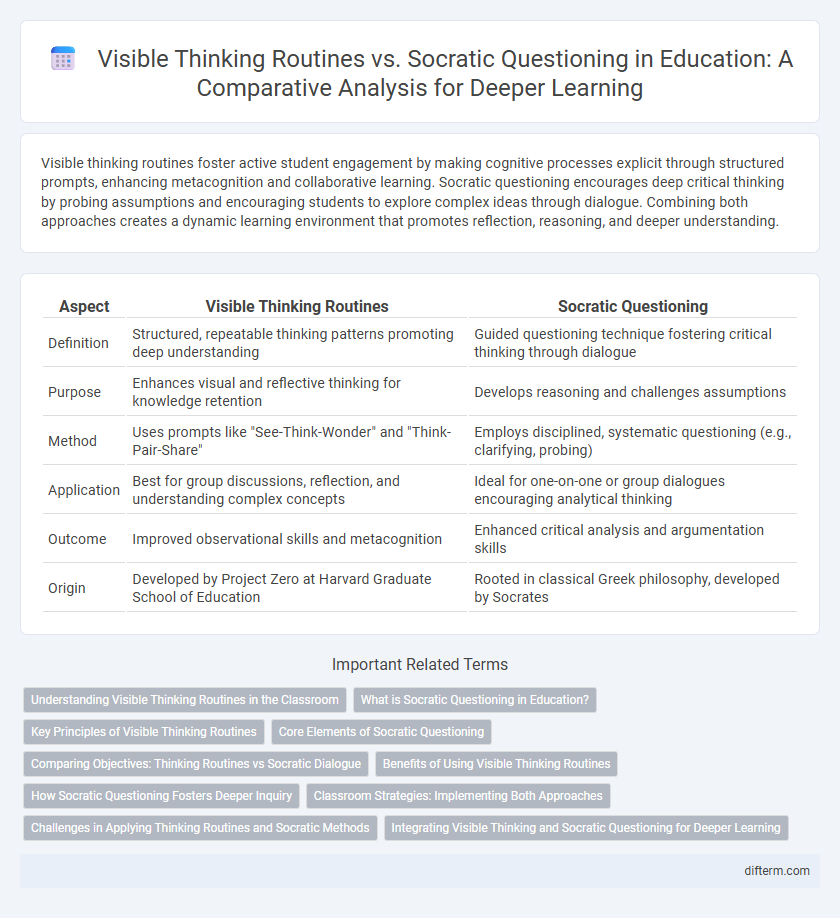Visible thinking routines foster active student engagement by making cognitive processes explicit through structured prompts, enhancing metacognition and collaborative learning. Socratic questioning encourages deep critical thinking by probing assumptions and encouraging students to explore complex ideas through dialogue. Combining both approaches creates a dynamic learning environment that promotes reflection, reasoning, and deeper understanding.
Table of Comparison
| Aspect | Visible Thinking Routines | Socratic Questioning |
|---|---|---|
| Definition | Structured, repeatable thinking patterns promoting deep understanding | Guided questioning technique fostering critical thinking through dialogue |
| Purpose | Enhances visual and reflective thinking for knowledge retention | Develops reasoning and challenges assumptions |
| Method | Uses prompts like "See-Think-Wonder" and "Think-Pair-Share" | Employs disciplined, systematic questioning (e.g., clarifying, probing) |
| Application | Best for group discussions, reflection, and understanding complex concepts | Ideal for one-on-one or group dialogues encouraging analytical thinking |
| Outcome | Improved observational skills and metacognition | Enhanced critical analysis and argumentation skills |
| Origin | Developed by Project Zero at Harvard Graduate School of Education | Rooted in classical Greek philosophy, developed by Socrates |
Understanding Visible Thinking Routines in the Classroom
Visible thinking routines in the classroom are structured strategies that promote deep cognitive engagement by making students' thought processes explicit and tangible. Unlike Socratic questioning, which relies on guided dialogue to elicit critical thinking, visible thinking routines use specific prompts and activities to help students organize, reflect, and communicate their understanding. Implementing these routines supports metacognition, encourages diverse perspectives, and fosters a collaborative learning environment where ideas are visually mapped and explored.
What is Socratic Questioning in Education?
Socratic questioning in education is a disciplined method of probing students' thinking through carefully crafted questions that promote critical analysis and deeper understanding. This technique encourages active engagement, reflection, and the development of reasoning skills by challenging assumptions and exploring underlying concepts. Unlike visible thinking routines, which use structured prompts to make thinking explicit, Socratic questioning focuses on fostering dialogue and intellectual inquiry to enhance comprehension.
Key Principles of Visible Thinking Routines
Visible thinking routines emphasize making students' thought processes explicit through structured, repeatable patterns that foster deeper understanding and reflection. These routines integrate key principles such as fostering curiosity, empowering learners to connect ideas, and developing metacognitive skills by encouraging observation, interpretation, and explanation. Unlike Socratic questioning, which relies on guided dialogue to stimulate critical thinking, visible thinking routines prioritize visual and verbal documentation to externalize and share cognitive strategies.
Core Elements of Socratic Questioning
Socratic questioning centers on core elements such as probing assumptions, seeking evidence, exploring viewpoints, and clarifying concepts to foster deep critical thinking. Visible thinking routines emphasize making thought processes explicit, but Socratic questioning uniquely drives learners to analyze and evaluate ideas through disciplined inquiry. Key strategies include asking open-ended questions that challenge reasoning and promote reflective dialogue in educational settings.
Comparing Objectives: Thinking Routines vs Socratic Dialogue
Visible thinking routines promote structured, scaffolded reflection to develop students' metacognitive skills and deepen understanding through visual and verbal cues. Socratic questioning centers on probing assumptions, evidence, and reasoning to stimulate critical thinking and foster dialectical engagement. Both approaches aim to enhance cognitive processes, but thinking routines focus on habitual patterns of thought, while Socratic dialogue prioritizes probing inquiry and argumentative reasoning.
Benefits of Using Visible Thinking Routines
Visible thinking routines enhance student engagement by making thought processes explicit and accessible, promoting deeper understanding through structured reflection. These routines encourage collaborative learning and critical thinking by guiding students to observe, interpret, and reason systematically. Visible thinking also supports metacognition, enabling learners to track their cognitive development and improve problem-solving skills in diverse educational settings.
How Socratic Questioning Fosters Deeper Inquiry
Socratic questioning fosters deeper inquiry by encouraging students to critically examine their assumptions and explore underlying concepts through disciplined dialogue. This method promotes analytical thinking and self-reflection, leading to a more profound understanding of complex topics compared to visible thinking routines that primarily focus on organizing and externalizing thoughts. By systematically challenging ideas and prompting evidence-based reasoning, Socratic questioning cultivates higher-order cognitive skills essential for advanced learning.
Classroom Strategies: Implementing Both Approaches
Visible thinking routines foster student engagement by encouraging observable cognitive processes through structured prompts like "See-Think-Wonder," enhancing critical thinking. Socratic questioning promotes deeper understanding by using open-ended, probing questions that challenge assumptions and stimulate reflective dialogue. Integrating both approaches creates a dynamic classroom environment where students develop metacognitive skills and analytical reasoning simultaneously.
Challenges in Applying Thinking Routines and Socratic Methods
Applying Visible Thinking Routines often encounters challenges such as time constraints, limited teacher training, and difficulty in maintaining student engagement across diverse learning styles. Socratic questioning, while effective for promoting critical thinking, faces obstacles including students' resistance to open-ended inquiry, discomfort with ambiguity, and the need for skilled facilitation to avoid superficial answers. Both methods require consistent practice and classroom culture shifts to foster deep, reflective thinking and meaningful dialogue.
Integrating Visible Thinking and Socratic Questioning for Deeper Learning
Integrating Visible Thinking routines with Socratic questioning enhances critical thinking and metacognition by prompting students to articulate reasoning and reflect on their learning process. Visible Thinking strategies like "See-Think-Wonder" complement Socratic questioning's emphasis on probing assumptions and evidence, fostering deeper engagement with complex concepts. This synergy cultivates a classroom environment where students actively construct knowledge through continuous dialogue and visual exploration.
Visible thinking routines vs Socratic questioning Infographic

 difterm.com
difterm.com